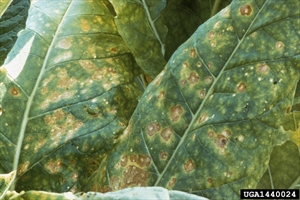Tobacco brown spot
Pacific Pests, Pathogens, Weeds & Pesticides - Online edition
Pacific Pests, Pathogens, Weeds & Pesticides
Tobacco brown spot (306)
Alternaria longipes. Note, that some accounts give the name of brown spot on tobacco as Alternaria alternata.
Asia, Africa, North, South and Central America, the Caribbean, Europe, Oceania. It is recorded on tabacco from Fiji, Papua New Guinea, and Vanuatu; on rice grains and rose cuttings from Papua New Guinea, and on capsicum from Tonga. It is present in Australia and New Zealand.
Tobacco. Reported from carrot, potato, sunflower and oil palm, but some reports (from the USA) suggest that only tobacco is naturally infected, and that artificial inoculations failed to infect potato, tomato and capsicum.
A fungal disease of tobacco. Small, round, pale brown leaf spots at first, expanding as the leaves mature, up 25 mm diameter, first on the lower leaves of plants in the field, and on older leaves of seedlings (Photo 1). The spots are zoned (target-like appearance) (Photo 2), surrounded by a dark margins and yellow halos. They may merge covering most of the leaf surface, and the centres of some spots fall out. In severe cases, on susceptible varieties, spots occur on the upper leaves and on the petioles and stems; on the petioles and stems the spots are elongated, sunken, dark brown, without yellow halos.
Spread is by airborne spores, or those splashed by water onto the lower leaves; spread may also occur when seeds are contaminated by debris containing spores. Survival occurs in debris, particularly on the leaves and stalks left after harvest. Rains and high temperatures (>26°C) are ideal for infection of the fungus and development of the disease.
Mostly, a minor disease, but when conditions are favourable - continuous crop production, susceptible varieties, frequent rains, and plants remaining in the field for longer than normal - considerable reduction in the quantity and quality of the tobacco crop is possible. Infected leaves are unsuitable as natural cigar 'wrappers' (the outer leaf), and have little value. In the USA, losses due to this disease average 0.5%. Significant losses are reported in many tobacco-growing areas of China each year.
Look for round, pale brown spots with dark margins and yellow halos up to 25 mm diameter. Look for spots with target-like rings.
CULTURAL CONTROL
The management of this disease is like that of tobacco frog-eye leaf spot (see Fact Sheet no. 304).
Before plants:
- Check plants in the nursery to make sure transplants are free from the disease.
- Avoid overlapping crops, preventing spores from older crops infecting newer ones. If not possible, then plant newer crops far from those established already.
- Remove volunteer plants of tobacco and others in the Solanum family before field planting.
During growth:
- Weed. Remove weeds, especially those related to tobacco, and volunteer plants from previous crops.
- If practical, and where numbers of plants are small, prune infected leaves as soon as they are seen.
- Do not add excessive amounts of nitrogen fertilizer as this increases the susceptibility of leaves. The correct balance between P, K and N is important, and soil analyses are required to determine this.
- Avoid overhead irrigation which splashes spores from soil and infected leaves, and wet leaves promoting spore germination and infection; in preference apply water through trickle tape.
After harvest:
- Collect and burn or bury trash after harvest, including all the leaves and stalks.
- Practice crop rotation. Do not grow tobacco for more than 2 years on the same land.
RESISTANT VARIETIES
Varieties have been bred for resistance to brown spot, and are in commercial production.
CHEMICAL CONTROL
If fungicides are required, use mancozeb, copper or chlorothalonil.
____________________
When using a pesticide, always wear protective clothing and follow the instructions on the product label, such as dosage, timing of application, and pre-harvest interval. Recommendations will vary with the crop and system of cultivation. Expert advice on the most appropriate pesticide to use should always be sought from local agricultural authorities.
AUTHORS Grahame Jackson & Eric McKenzie
Information from Dingley JM, et al. (1981) Survey of agricultural pests and diseases. Technical Report. Volume 2. Records of fungi, bacteria, algae and angiosperms pathogenic on plants in Cook Islands, Fiji, Kiribati, Niue, Tonga, Tuvalu and Western Samoa. FAO, Rome, Italy; and from Brown spot (Alternaria longipes) Plantwise Knowledge Bank. (http://www.plantwise.org/KnowledgeBank/Datasheet.aspx?dsid=4514). Photos 1&2 R.J. Reynolds Tobacco Company Slide Set, R.J. Reynolds Tobacco Company, Bugwood.org.
Produced with support from the Australian Centre for International Agricultural Research under project PC/2010/090: Strengthening integrated crop management research in the Pacific Islands in support of sustainable intensification of high-value crop production, implemented by the University of Queensland and the Secretariat of the Pacific Community.





